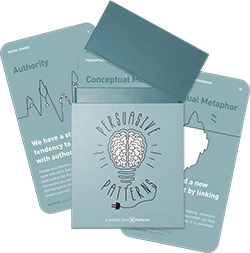Value Attribution
Design Pattern
Alternate titles: Attribution Theory.
Problem summary
The perceived value of things increases with their cost and appearance
Usage
- Use to increase the perceived value of your product
- Use to stand out from your competition
This card is part of the Persuasive Patterns printed card deck
The Persuasive Patterns Card Deck is a collection of 60 design patterns driven by psychology, presented in a manner easily referenced and used as a brainstorming tool.
Get your deck!Solution
We tend to attribute the value, goodness, or authenticity of something to its context instead of the thing itself
- Stand out. Consider positioning core traits of your product to significantly stand out from the competition to increase the perceived value of your product. It could be with a much higher price (or price one plan of many higher to let it act as a decoy), remarkablel brand, or acting with attitudes contrary to the established market.
- Invested time as cost. Consider whether you can get users to invest their time in your product before paying to use it. This might increase its perceived monetary value.
- Attribution decays. The perceived value we infer from value attribution decays over time as we both have time to compare and contrast with more evidence. A conversion to sale is most likely to happen as the value attribution is assigned.
Rationale
We tend to assign unobservable traits to people and things based on its context and a few predominant cues rather than objective data. A high price may induce perceived qualities not seen if priced lower. An attractive appearance may infer a perception that a product works better. As we evaluate the value and traits of a product, cues like price, brand, appearance, and behavior have significant influence.
Discussion
We also use attribution theory to explain why a particular event or outcome has occurred, why an experience met a users experiential needs, or why the experience was to the users’s liking
If we itemised the stages of such an experience and the process of value attribution, it would look something like this:
- What happened? – outside events do not exist unless we are aware of them
- Moods, emotions, feelings – how we interpret the event
- Perceived duration – involvement
- Cognitive components – intentions move our minds and focus
- Sense of competence/control – we use to perfect our skills
- Sense of freedom – objective and subjective perception of control
Attribution theories address the issue of how people, from limited available evidence, infer unobservable characteristics about things. The undisputed founder of attribution theory is Fritz Heider, however the theory was further advanced by Harold Kelley and Bernard Weiner. Attribution theory has been criticised as being mechanistic and reductionist for assuming that people are rational, logical, and systematic thinkers. Robert Settle started applying attribution theory to marketing in the 1970.
1 Attribution theory at Wikipedia.org
2 Heider, F. (1958). The psychology of interpersonal relations. New York: Wiley
Settle, R. (1972).
3 Attribution theory and acceptance of information, JMR, Journal of Marketing Research (pre-1986), Vol 9
4 Bertram F. Malle (2011). Attribution theories: How people make sense of behavior, Theories in social psychology (pp.72-95), Edition: 1st, Wiley-Blackwell
5 Carol A. Scott (1982) ,On Using Attribution Theory to Understand Advertising Effects, in NA – Advances in Consumer Research Volume 09, eds. Andrew Mitchell, Ann Abor, MI : Association for Consumer Research, Pages: 293-295.
6 R. E. Burnkrant (1975) ,Attribution Theory in Marketing Research: Problems and Prospects, in NA – Advances in Consumer Research Volume 02, eds. Mary Jane Schlinger, Ann Abor, MI : Association for Consumer Research, Pages: 465-470.
7 Value Attribution at Learning Loop
User Interface Design Patterns
- Forms
- Explaining the process
- Community driven
- Tabs
- Jumping in hierarchy
- Menus
- Content
- Gestures
- Tables
- Formatting data
- Images
- Search
- Reputation
- Social interactions
- Shopping
- Increasing frequency
- Guidance
- Registration
Persuasive Design Patterns
- Loss Aversion
- Other cognitive biases
- Scarcity
- Gameplay design
- Fundamentals of rewards
- Gameplay rewards


